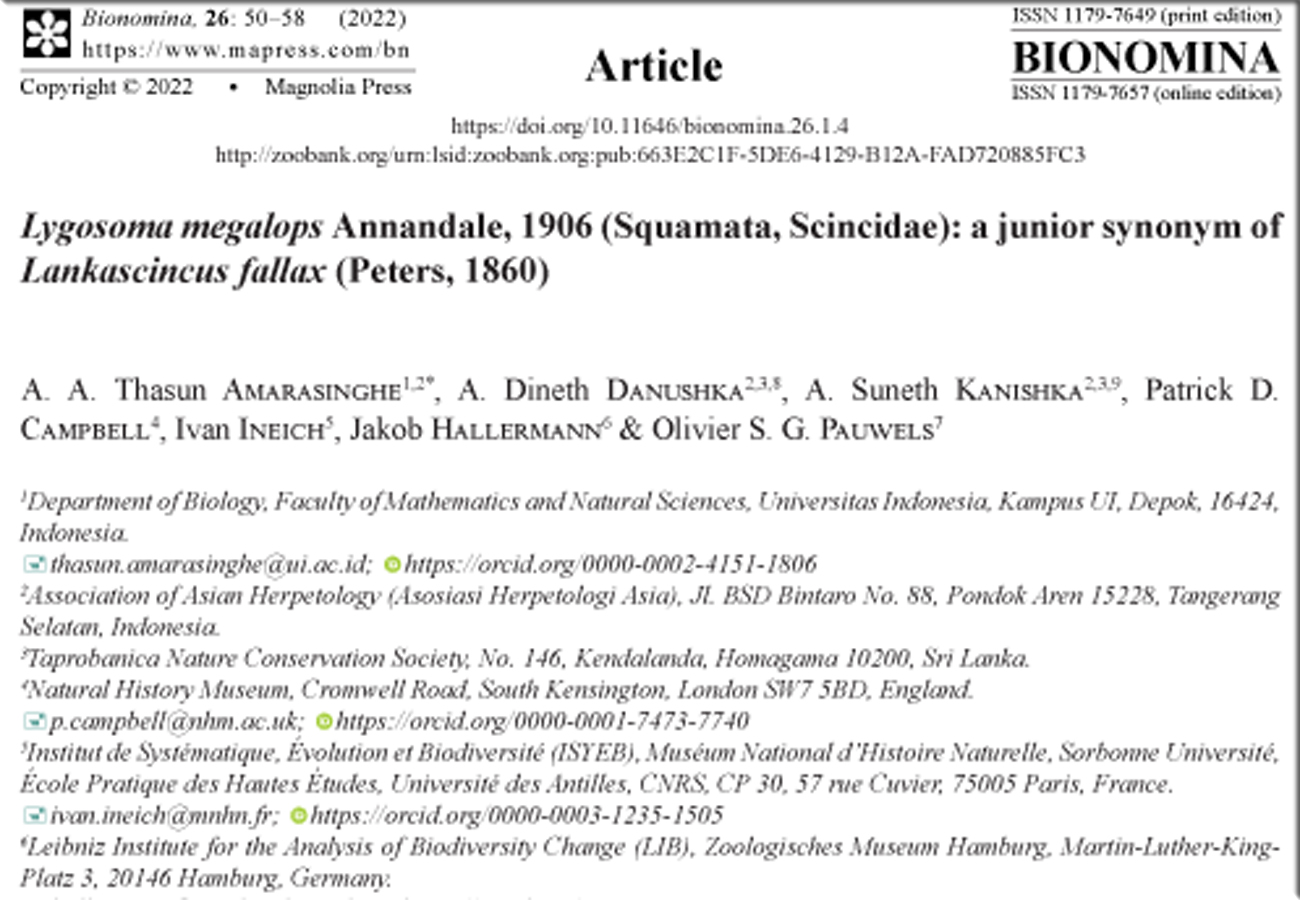Abstract
Annandale (1906) described Lygosoma megalops, now in the genus Lankascincus, based on two syntypes collected from Kitulgala and Puttalam in Sri Lanka. These syntypes have not been recognized since the original description. In 2019, Batuwita designated a neotype, WHT 6545, for Ly. megalops from Kitulgala. The number WHT ‘6545’ does not exist in the registers of either WHT or NMSL. The neotype designation also fails to conform to several Articles of the Code: 75.3.1, 75.3.3, 75.3.5 and 75.3.7. Given that it does not appear to exist, it makes the designation of ‘WHT 6545’ as the neotype of Ly. megalops void ab initio. Further, based on the description provided in Batuwita (2019), it is clear that the species he conceived as Ly. megalops was in fact morphologically similar to several other Lankascincus species. We show that, as characterized by Annandale (1906), Ly. megalops cannot be assigned to any scincid species in Sri Lanka. The locality data Annandale disclosed for Ly. megalops—Puttalam and Kitulagala—make it almost certain that the two syntypes belonged to different species or to La. fallax. Therefore, unless resolved, the nomen La. megalops will continue to threaten the nomenclatural stability in the genus Lankascincus, as well as in the genus Eutropis. In order to address this problem, we invalidate the neotype designated by Batuwita (2019) and show that Ly. megalops is a synonym of La. fallax.
References
Anonymous [International Commission on Zoological Nomenclature] (1999) International code of zoological nomenclature. ‘Fourth edition’. London (International Trust for zoological Nomenclature): i–xxix + 1–306.
Amarasinghe, A. A. T. (2020) Cladonotus bhaskari: a call for improving ethical standards in taxonomic journals. Taprobanica, 9: 133–135. <https://doi.org/10.47605/tapro.v9i2.227>.
Annandale, A. (1906) New and interesting lizards in Colombo museum. Spolia zeylanica, 3: 189–192.
Batuwita, S. (2019) A review of the endemic genus Lankascincus (Reptilia: Scincidae: Lygosominae) from Sri Lanka. Bulletin of the Museum of comparative Zoology, 162: 211–262. <https://doi.org/10.3099/MCZ38.1>.
Batuwita, S. & Pethiyagoda, R. (2007) Description of a new species of Sri Lankan litter skink (Squamata: Scincidae: Lankascincus). Ceylon Journal of Science (Bio Science), 36: 80–87. <https://doi.org/10.4038/cjsbs.v36i2.482>.
Danushka, A. D., Kanishka, A. S., Thuse, H. S. P., Hallermann, J., Campbell, P. D., Ineich, I., Pauwels, O. S. G. & Amarasinghe, A. A. T. (in press) Taxonomy, distribution, and conservation of Lankascincus dorsicatenatus (Deraniyagala, 1953) (Reptilia: Scincidae) with designation of a neotype. Russian Journal of Herpetology, accepted.
Das, I., Silva, A. de, Austin, C. C. (2008) A new species of Eutropis (Squamata: Scincidae) from Sri Lanka. Zootaxa, 1700: 35–52. <https://doi.org/10.11646/zootaxa.1700.1.3>.
Deraniyagala, P. E. P. (1953) A coloured atlas of some Vertebrates from Ceylon. Volume 2. Tetrapod Reptilia. Colombo (The Ceylon Government Press): i–vii + 1–119.
Duméril, A. M. C. & Bibron, G. (1839) Erpétologie générale ou Histoire naturelle complète des Reptiles. Tome 5. Paris (Librairie Encyclopédique de Roret): i–viii + 1–855.
Engel, M. S., Ceríaco, L. M. P., Daniel, G. M., Dellapé, P. M., Löbl, I., Marinov, M., Reis, R. E., Young, M. T., Dubois, A. et al. [77 signatories] (2021) The taxonomic impediment: a shortage of taxonomists, not the lack of technical approaches. Zoological Journal of the Linnean Society, 193: 381‒387. <https://doi.org/10.1093/zoolinnean/zlab072>.
Fitzinger, L. (1843) Systema Reptilium, fasciculus primus, Amblyglossae. Wien (Braumüller et Seidel): 1–106 + i–vi. <https://doi.org/10.5962/bhl.title.4694>.
Greer, A. E. (1991) Lankascincus, a new genus of skink lizards from Sri Lanka, with description of three new species. Journal of Herpetology, 25: 59–64. <https://doi.org/10.2307/1564795>.
Hardwicke, T. & Gray, J. E. (1828) A synopsis of the species of saurian reptiles, collected in India by Major-General Hardwicke. The zoological Journal, 3: 213–229.
Kanishka, A. S., Danushka, A. D. & Amarasinghe, A. A. T. (2020) A new species of Lankascincus Greer, 1991 (Reptilia: Scincidae) with an overview of the L. gansi group. Taprobanica, 9: 102–119. <https://doi.org/10.47605/tapro.v9i1.225>.
Kelaart, E. F. (1854) Descriptions of new Ceylon reptiles. The Annals and Magazine of natural History, (2), 13: 407–408. <https://doi.org/10.1080/03745485709496363>.
Peters, W. C. H. (1860) Über einige interessante Amphibien, welche von dem durch seine zoologischen Schriften rühmlichst bekannten österreichischen Naturforscher Professor Schmarda während seiner auf mehrere Welttheile ausgedehnten, besonders auf wirbellose Thiere gerichtet. Monatsberichte der Königlichen Akademie der Wissenschaften zu Berlin, 1860: 182–186.
Samarasinghe, D. J. S., Wikramanayake, E. D., Jayakody, S., Fernando, S., Gunawardana, J. & Braczkowski, A. (2020) A biodiversity hotspot in turmoil: doing away with circular 5/2001 could have catastrophic consequences for Sri Lanka’s forests. Conservation Science & Practice, 2020: e466. <https://doi.org/10.1111/csp2.466>.
Somaweera, R. & Somaweera, N. (2009) Lizards of Sri Lanka: a colour guide with field keys. Frankfurt-am-Main, Germany (Chimaira): 1–304. <https://doi.org/10.47605/tapro.v1i1.9>.
Sudasinghe, H., Herath, J., Pethiyagoda, R. & Meegaskumbura, M. (2018) Undocumented translocations spawn taxonomic inflation in Sri Lankan fire rasboras (Actinopterygii, Cyprinidae). PeerJ, 6: e6084. <https://doi.org/10.7717/peerj.6084>.
Sudasinghe, H. & Pethiyagoda, R. (2019) A commentary on the taxonomic review of Sri Lankan Devario by Batuwita et al. 2017 (Teleostei: Danionidae). Zootaxa, 4543: 421–430. <https://doi.org/10.11646/zootaxa.4543.3.7>.
Taylor, E. H. (1950) Ceylon lizards of the family Scincidae. University of Kansas Science Bulletin, 33: 481–518. <https://doi.org/10.5962/bhl.part.16133>.
Uetz, P., Cherikh, S., Shea, G., Ineich, I., Campbell, P. D., Doronin, I. V., Rosado, J., Wynn, A., Tighe, K. A. et al. [21 signatories] (2019) A global catalog of primary reptile type specimens. Zootaxa, 4695: 438–450. <https://doi.org/10.11646/zootaxa.4695.5.2>.
Wickramasinghe, L. J. M., Rodrigo, R., Dayawansa, N. & Jayantha, U. L. D. (2007) Two new species of Lankascincus (Squamata: Scincidae) from Sripada Sanctuary (Peak Wilderness), in Sri Lanka. Zootaxa, 1612: 1–24. <https://doi.org/10.11646/zootaxa.1612.1.1>.
Wickramasinghe, L. J. M., Vidanapathirana, D. R. & Wickramasinghe, N. (2020) A new species of Lankascincus Greer, 1991 (Reptilia: Scincidae) from the Rakwana hills of Sri Lanka. Taprobanica, 9: 23–30. <https://doi.org/10.47605/tapro.v9i1.218>.
Wilson, E. O. (2005) Systematics and future of biology. Procedings of the national Academy of Sciences, 102: 6520–6521. <https://doi.org/10.1073/pnas.0501936102>.


